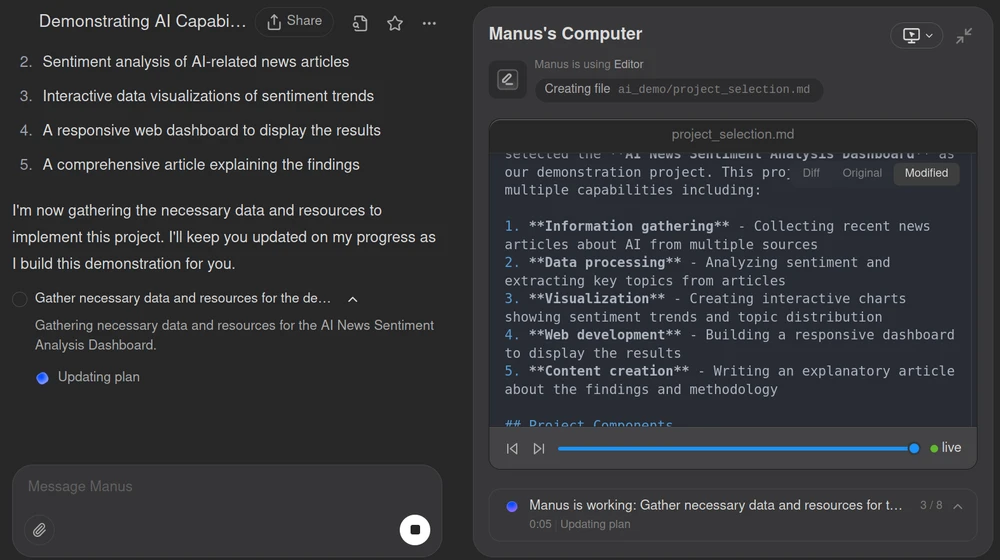Local AI Unleashed: The Future of Private Computing with NVIDIA, Apple, and AMD
For years, I’ve been haunted by a vision: a dedicated AI powerhouse on my desk, free from the constraints of cloud subscriptions and the limitations of repurposed gaming PCs. I don’t want a mining rig or a flashy gaming setup—I want a sleek, purpose-built machine that can handle large language models (LLMs), embeddings, and fine-tuning with ease. Traditional gaming PCs, despite their robust memory bandwidth, stumble with VRAM bottlenecks, leading to sluggish inference, timeouts, and model hallucinations. These frustrations have fueled sleepless nights, but the tide is turning. A new generation of hardware from NVIDIA, Apple, and AMD is making local AI not just possible, but practical.
The spark ignited when NVIDIA unveiled their DGX Spark at GTC 2025 (3-minute YouTube overview), heralding a new market for local AI computing systems. Manufacturers are now racing to deliver compact, high-performance solutions, and NVIDIA isn’t alone. Apple’s M4 MAX Mac Studio and AMD’s Ryzen AI MAX +395, available in models like the Beelink GTR9 Pro and the GMKtec EVO-X2 (GMKtec EVO-X2), are redefining what’s achievable at home. In this in-depth exploration, we’ll dissect these three contenders, comparing their specs, use cases, and market impact to help you choose the perfect AI machine for your needs.
Why Local AI Matters
The allure of local AI lies in its promise of privacy, cost savings, and flexibility. For developers, it’s a testing ground before deploying models to datacenters; for enthusiasts, it’s a playground for creative projects. Yet, traditional hardware like gaming PCs falls short, with VRAM limitations crippling tasks like running high-quality LLMs or managing vector databases. The new wave of AI-specific devices addresses these pain points, offering tailored performance for inference, fine-tuning, and development. This shift is creating a vibrant market, with NVIDIA, Apple, and AMD leading the charge. Let’s dive into the details of each device.
NVIDIA DGX Spark: The Scalable AI Supercomputer
Introduced as Project DIGITS in January 2025 and rebranded as DGX Spark at GTC 2025, NVIDIA’s offering is a compact AI supercomputer targeting developers, researchers, and students. Priced from $2,999 (1TB SSD) to $3,999 (4TB SSD), it’s slated for release in June 2025. With 1,000 TOPS of AI performance and a unique NVLink ConnectX-7 port, it’s designed for scalability, making it a top choice for clustered AI workloads. Official NVIDIA DGX Spark Announcement
Technical Specifications
The DGX Spark is powered by the NVIDIA GB10 Grace Blackwell Superchip, integrating a 20-core Armv9 CPU (10 Cortex-X925, 10 Cortex-A725) with a Blackwell GPU featuring fifth-generation Tensor Cores. Its 128GB LPDDR5X unified memory supports models up to 200 billion parameters locally, and up to 405 billion when clustered. The NVLink ConnectX-7 port delivers 400GB/s bandwidth—five times faster than Apple’s Thunderbolt 5—for seamless multi-unit clustering. However, its 273 GB/s memory bandwidth is a noted limitation compared to the RTX 5090’s 1792 GB/s VRAM bandwidth, potentially slowing production tasks. ServeTheHome Review
- AI Performance: 1,000 TOPS with FP4 support, ideal for inference and fine-tuning.
- Clustering: NVLink ConnectX-7 enables direct memory transfers, enhancing scalability.
- Connectivity: Includes HDMI 2.1a, 4x USB4, 10GbE, WiFi 7, and 200GbE RDMA.
- Software: NVIDIA DGX OS (Ubuntu 22.04-based) with CUDA, NIM, and preinstalled models like DeepSeek R1.
Use Cases and Limitations
The DGX Spark excels for developers prototyping large-scale AI models, particularly in research or enterprise settings where clustering is key. Its NVIDIA software ecosystem ensures compatibility with tools like TensorFlow and PyTorch, and its preinstalled AI models streamline setup. However, the limited memory bandwidth may hinder production-grade tasks, such as real-time inference in high-demand environments, and its Linux-only OS may not suit users accustomed to Windows or macOS. For those prioritizing scalability, the DGX Spark’s clustering capabilities make it a future-proof investment, though improvements in bandwidth are needed for broader production use. CNX Software DGX Spark Details
Availability and Distribution
The DGX Spark is offered by multiple partners with identical specs, ensuring flexibility in purchasing options:
Reservations are open, with shipping expected in June 2025. For a deeper look at its design and clustering potential, check out this overview: TechEBlog Overview
Apple M4 MAX Mac Studio: The Bandwidth Champion
Apple’s M4 MAX Mac Studio, starting at $1,999, is a compact powerhouse leveraging unified memory architecture to deliver exceptional performance for AI and creative workloads. Its 410–546 GB/s memory bandwidth sets a high bar, making it a favorite for professionals within the Apple ecosystem. Launched in October 2024 as part of the M4 family, it’s already a go-to choice for creatives and AI enthusiasts. Official Apple Mac Studio Specs
Technical Specifications
The M4 MAX Mac Studio features a 14-core or 16-core CPU, a 32-core or 40-core integrated GPU, and a 16-core Neural Engine optimized for on-device AI tasks. With up to 96GB of unified LPDDR5x memory (configurable to 128GB in higher tiers), it supports rapid inference for LLMs and creative tasks like 8K video editing. Its memory bandwidth, ranging from 410GB/s to 546GB/s, doubles that of the DGX Spark, ensuring fast data access for memory-intensive workloads. The system is remarkably energy-efficient, consuming an estimated 120W, and offers extensive connectivity for professional setups. PCMag M4 Max Review
- Unified Memory: 36GB or 96GB (up to 128GB), with 410–546 GB/s bandwidth for superior performance.
- Neural Engine: Accelerates tasks like image generation and machine learning model training.
- Ports: Front: 2x USB-C, SDXC; Back: 4x Thunderbolt 5, 2x USB-A, HDMI 2.1, 10Gb Ethernet, 3.5mm headphone jack.
- Networking: Wi-Fi 6E, Bluetooth 5.3, and 10Gb Ethernet for robust connectivity.
Use Cases and Limitations
The M4 MAX Mac Studio is tailored for creatives using tools like Final Cut Pro, Adobe Premiere, or DaVinci Resolve, and AI enthusiasts running models within macOS. Its high bandwidth supports real-time 3D rendering, generative AI, and multi-stream video editing, making it a versatile workstation. For AI tasks, the Neural Engine handles lightweight models efficiently, but it trails NVIDIA’s 1,000 TOPS Tensor Cores for specialized, large-scale AI workloads. The macOS ecosystem, while seamless, limits OS flexibility, which may deter users needing Linux or Windows for specific frameworks. Additionally, its premium pricing for higher configurations (e.g., 128GB memory, 8TB SSD) can exceed $3,999, rivaling the DGX Spark. Apple M4 Announcement
Availability and Distribution
The M4 MAX Mac Studio is available now through Apple’s online store, with customizable options for memory (36GB to 128GB) and storage (512GB to 8TB SSD). Its immediate availability gives it an edge over the DGX Spark’s June 2025 release. Apple Store
AMD Ryzen AI MAX +395: Versatility and Value
AMD’s Ryzen AI MAX +395, part of the Strix Halo family, powers two standout mini PCs: the Beelink GTR9 Pro and the GMKtec EVO-X2. Priced from $1,399 to $1,999, these devices offer unmatched flexibility with Windows 11 or Linux support, making them ideal for AI development, gaming, and general-purpose workloads. The GMKtec EVO-X2, launched on April 7, 2025, in China, is marketed as the world’s first Windows 11 AI+ PC APU, supporting 70B LLMs and delivering 2.2x the AI performance of an RTX 4090 in LM Studio, a bold claim that’s sparked excitement among enthusiasts. GMKtec EVO-X2
Beelink GTR9 Pro: Affordable Power
The Beelink GTR9 Pro, priced at $1,999, features the Ryzen AI MAX +395 with 16 Zen 5 cores (32 threads, up to 5.1 GHz), a Radeon 8060S integrated GPU with 40 RDNA 3.5 compute units, and an XDNA 2 NPU delivering 50 TOPS (126 TOPS total with CPU/GPU). Its 128GB LPDDR5X-8000 memory, with an estimated 128 GB/s bandwidth, supports models up to 70B parameters, making it suitable for mid-sized AI tasks. Dual M.2 slots for PCIe 4.0 NVMe SSDs offer flexible storage, and its extensive port selection caters to diverse setups. Beelink GTR9 AI Announcement
- Performance: 50 TOPS NPU, with gaming performance comparable to an RTX 4070 in specific scenarios.
- Ports: Front: 4 mics, 3.5mm audio, SD card reader, USB-C; Back: 2x USB4, 2x 10Gbps Ethernet, HDMI, DisplayPort, 2x USB 3.0.
- Networking: Dual 10Gbps Ethernet and assumed Wi-Fi support for high-speed connectivity.
Pros: Competitive pricing, OS flexibility, and high memory capacity make it a versatile choice for AI and gaming. Cons: The 50 TOPS NPU is less powerful than NVIDIA’s 1,000 TOPS, and AMD’s AI software ecosystem is less mature, relying on frameworks like ONNX rather than NVIDIA’s CUDA. NotebookCheck GTR9 Pro
GMKtec EVO-X2: Premium AI Performance
The GMKtec EVO-X2, launched globally with pre-orders starting April 7, 2025, is priced at $1,399 (64GB RAM, 1TB SSD) to $1,799 (128GB RAM, 2TB SSD), with pre-order discounts reducing costs to as low as $1,199 with a $200 deposit. It features the same Ryzen AI MAX +395, with 16 Zen 5 cores, a Radeon 8060S iGPU, and a 50 TOPS XDNA 2 NPU. Its 128GB LPDDR5X-8000 memory and 140W TDP enable high-performance AI tasks, supporting 32B LLaMA4 and 109B DeepSeek models. The EVO-X2’s advanced cooling system, with dual-turbine fans and a vapor chamber, ensures stability under heavy loads, and its connectivity includes Wi-Fi 7 and 2.5Gbps Ethernet. GMKtec EVO-X2 Pre-Order
- AI Capabilities: Outperforms RTX 5090D in specific AI tasks (e.g., LM Studio), supporting 70B LLMs.
- Connectivity: 2x USB-C (40 Gbps), 4x USB, DisplayPort 2.0, HDMI 2.1, SD card reader, audio jack.
- Design: Premium black/gold aesthetic, larger form factor (5x4.5 inches) for enhanced cooling.
Pros: Exceptional AI performance for the price, robust cooling, and pre-order discounts. Cons: Higher list price in some regions ($2,052 in China), lack of OCuLink port for external GPUs, and less developed AI software support. VideoCardz EVO-X2 Details
Availability and Distribution
The Ryzen AI MAX +395 is available through two key distributors, offering distinct pricing and features:
- Beelink: GTR9 AI ($1,999, available now)
- GMKtec: EVO-X2 ($1,399–$1,799 with pre-order discounts, shipping May 20, 2025)
Pre-orders for the GMKtec EVO-X2 are available on Amazon and GMKtec’s official site, with incentives like $200 off for a $100 deposit or $400 off for a $200 deposit. This makes the EVO-X2 particularly attractive for early adopters. Liliputing GMK EVO-X2 Pre-Order
Specs Comparison Table
To help you choose the best device for your needs, here’s a detailed comparison of the NVIDIA DGX Spark, Apple M4 MAX Mac Studio, and AMD Ryzen AI MAX +395 (Beelink GTR9 Pro and GMKtec EVO-X2):
| Specification |
NVIDIA DGX Spark |
Apple M4 MAX Mac Studio |
AMD Ryzen AI MAX +395 (Beelink GTR9 Pro) |
AMD Ryzen AI MAX +395 (GMKtec EVO-X2) |
| CPU |
20-core Armv9 (10 Cortex-X925, 10 Cortex-A725) |
Apple M4 Max (14-core or 16-core) |
16 Zen 5 cores, 32 threads, up to 5.1 GHz |
16 Zen 5 cores, 32 threads, up to 5.1 GHz |
| GPU |
Blackwell GPU |
Integrated GPU (32-core or 40-core) |
Integrated Radeon 8060S (40 RDNA 3.5 CUs) |
Integrated Radeon 8060S (40 RDNA 3.5 CUs) |
| Neural/AI Acceleration |
5th Gen Tensor Cores, FP4, 1,000 TOPS |
16-core Neural Engine |
XDNA 2 NPU, 50 TOPS (126 TOPS total) |
XDNA 2 NPU, 50 TOPS (126 TOPS total) |
| System Memory |
128GB LPDDR5X |
36GB or 96GB unified memory (LPDDR5x) |
Up to 128GB LPDDR5X-8000 (soldered) |
64GB or 128GB LPDDR5X-8000 (soldered) |
| Memory Bandwidth |
273 GB/s |
410GB/s or 546GB/s |
~128 GB/s (estimated) |
~128 GB/s (estimated) |
| Storage |
1TB or 4TB SSD |
512GB SSD (base), up to 8TB SSD |
Dual M.2 slots for PCIe 4.0 NVMe SSDs |
1TB or 2TB NVMe PCIe 4.0 SSD |
| Ports |
HDMI 2.1a, 4x USB4 |
Front: 2x USB-C, SDXC; Back: 4x Thunderbolt 5, 2x USB-A, HDMI 2.1, 10Gb Ethernet, 3.5mm |
Front: 4 mics, 3.5mm audio, SD, USB-C; Back: 2x USB4, 2x 10Gbps Ethernet, HDMI, DisplayPort, 2x USB 3.0 |
2x USB-C (40 Gbps), 4x USB, DisplayPort 2.0, HDMI 2.1, SD card reader, audio jack |
| Networking |
10GbE, WiFi 7, 200GbE RDMA |
Wi-Fi 6E, Bluetooth 5.3, 10Gb Ethernet |
Dual 10Gbps Ethernet, Wi-Fi (assumed) |
Wi-Fi 7, 2.5Gbps Ethernet |
| OS |
NVIDIA DGX OS (Ubuntu 22.04) |
macOS |
Windows 11 (Linux compatible) |
Windows 11 (Linux compatible) |
| Power Consumption |
170W |
~120W (estimated) |
Up to 230W |
Up to 140W |
| Price |
$2,999 - $3,999 |
Starting at $1,999 |
$1,999 |
$1,399 (64GB/1TB) - $1,799 (128GB/2TB) |
Choosing Your Local AI Machine
Each device targets distinct audiences, making your choice a matter of priorities:
NVIDIA DGX Spark: Scalable AI Development
With 1,000 TOPS and NVLink clustering, the DGX Spark is unmatched for developers building large-scale AI models, particularly in research labs or startups. Its Ubuntu-based OS and NVIDIA software stack (CUDA, NIM) ensure seamless integration with enterprise tools like TensorFlow and PyTorch. Priced at $2,999–$3,999, it’s a premium investment, but its 273 GB/s bandwidth may limit production use, such as real-time inference in high-demand scenarios. Choose this for scalability and AI-specific performance. Hardware Corner NVIDIA Comparison
Apple M4 MAX Mac Studio: Creative Powerhouse
The M4 MAX Mac Studio’s 410–546 GB/s bandwidth and compact design make it perfect for creatives and AI enthusiasts within the Apple ecosystem. Starting at $1,999, it excels in tasks like 3D rendering, generative AI, and multi-stream video editing, leveraging its Neural Engine for on-device processing. However, macOS restricts flexibility for users needing Linux or Windows, and higher configurations can push costs above $3,999. Select this for seamless macOS integration and energy efficiency.
AMD Ryzen AI MAX +395: Versatile Value
The Beelink GTR9 Pro ($1,999) and GMKtec EVO-X2 ($1,399–$1,799) offer flexibility and affordability. The EVO-X2 stands out with its 70B LLM support and claimed 2.2x RTX 4090 AI performance in LM Studio, making it a premium choice for AI enthusiasts. The GTR9 Pro balances cost and performance, suitable for mid-sized models and gaming. Both support Windows 11 or Linux, catering to diverse use cases from AI development to general workstations. The EVO-X2’s pre-order discounts and advanced cooling make it particularly compelling. Choose these for value, versatility, and competitive AI performance. Tom’s Hardware EVO-X2
Market Impact and Future Outlook
The local AI revolution is reshaping the computing landscape, with NVIDIA, Apple, and AMD addressing distinct market segments. NVIDIA’s DGX Spark sets the standard for enterprise-grade AI with its clustering capabilities, Apple’s M4 MAX Mac Studio caters to creatives with unparalleled bandwidth, and AMD’s Ryzen AI MAX +395 democratizes access with affordable, versatile options. Posts on X reflect excitement for the GMKtec EVO-X2, with users like @renatofontes praising its 128GB RAM and $1,799 price point, though some criticize its higher list price in China ($2,052). These sentiments highlight the growing demand for cost-effective AI hardware, balanced against concerns about value and software maturity.
Looking forward, advancements in memory bandwidth, NPU performance, and AI software ecosystems will further enhance local AI capabilities. NVIDIA’s CUDA dominance may face challenges as AMD and open-source frameworks like ONNX gain traction. Apple’s focus on unified memory could inspire competitors, while AMD’s aggressive pricing (e.g., EVO-X2’s $1,399 entry point) sets a new benchmark for accessibility. As of May 9, 2025, these devices, priced from $1,399 to $3,999, are making private AI a reality for developers, creatives, and enthusiasts alike.
Which device are you eyeing for your AI projects? Share your thoughts in the comments below, and let’s discuss the future of local AI computing!
Sources




